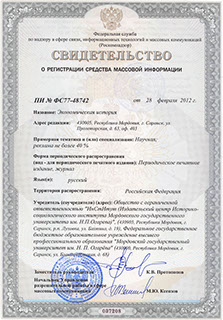Экономическая историЯ
Russian Journal of Economic History
ISSN 2409-630X (Print)
ISSN 2618-916X (Online)
Expert board:
- Scientific Council of RAS on economic history;
- Research and Educational Center «The economic history of Central Russia and the Middle Volga region» of Ogarev Mordovia State University;
- Center of Economic History of Lomonosov Moscow State University
Navigation
Certificate of registration

ISSN 2409-630X (Print), ISSN 2618-916X (Online)
DOI: 10.15507/2409-630X.054.017.202103.276-284
Oleg I. Mariskin
National Research Mordovia State University (Saransk, Russia),
е-mail: mariskinoi@mail.ru
Collective Farm Village of Mordovia in the Post-War Period
Introduction. The article explores the state of the collective farm village of Mordovia in the post-war period, when the peasantry went through a difficult and contradictory path of development, having experienced all the consequences of state policy, which was characterized mainly by the use of repressive measures and increased taxes. At the same time, the moral encouragement of the leaders of collective farm production was used, the material and technical base of collective farms was gradually strengthened. Results and Discussion. Yield growth, livestock and productivity of public animal husbandry, the strengthening of the economy of farms largely depended on the efficiency of the work of collective farmers, state farm workers, advanced production workers, agricultural production specialists. The improvement of the material well-being and cultural level of the workers of the region, first of all, was expressed in the growth of the monetary income of collective farmers, workers and employees, in housing construction. The reduction of the agricultural tax in 1953, the increase in procurement and purchase prices for agricultural products, the decrease in retail prices for some food and industrial goods, the transition to monthly and quarterly advance payment of labor changed not only the economic situation, but also the psychological climate in the village: the social and labor activity of people increased, the migration of the rural population of Mordovia decreased. Conclusion. The progressive measures implemented after September 1953 soon exhausted themselves due to systemic reasons and contradictory subjective decisions.
Keywords: the post-war period, peasantry, collective farms, agricultural industry, everyday life, population, Mordovia, Atyashevsky district.
For citation: Mariskin O. I. Collective Farm Village of Mordovia in the Post-War Period. Ekonomicheskaya istoriya = Russian Journal of Economic History. 2021; 17(3): 276–284. (In Russ.). DOI: 10.15507/2409-630X.054.017.202103.276-284.
© Ogarev Mordovia State University. History and Sociology Institute, 2017
68, Of. 411, Bolshevistskaya St., 430005, The editorial office of the scholarly journal «Russian Journal of Economic History»
Tel.: (8342) 24-25-90; 27-07-11, Fax: (8342) 24-25-90, E-mail: jurnal-econom-hist@isi.mrsu.ru
Designed by A. Napalkov, Email: napalkov@isi.mrsu.ru

